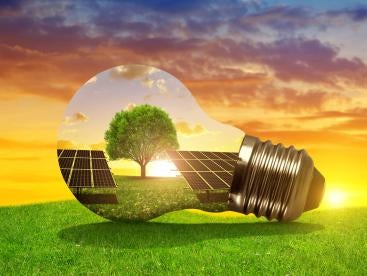The COVID-19 pandemic is raising numerous concerns for renewable energy projects under development in the United States.
-
First, will Congress address renewable energy industry concerns in the coming round of the COVID-19 legislative debate, or soon thereafter, by extending renewable energy tax credit programs or otherwise?
-
Second, can renewable energy facilities under development in the United States continue construction right now, given stay-at-home orders and other COVID-19 protection measures?
-
Third, are certain renewable energy projects in process at risk of failing to satisfy the safe harbor for start of construction by December 31, 2019, which is necessary to claim certain renewable energy tax credits, as a result of their being unable to take delivery of the equipment paid for within the Treasury-mandated 105 day window due to disruptions caused by COVID-19?
-
Congress – Stimulus Phase Four.
While Congress waits to take stock of the effects of the first three phases of the COVID-19 response, and the trillions of dollars of promised relief funds, attention has turned to what inevitable future relief packages might bring. This conversation has been driven primarily by House Speaker Pelosi, who in recent days has shifted her messaging to focus on a narrower set of issues tied solely to the social and economic disruptions caused by the pandemic. In a Letter to House colleagues on April 4, she announced her desire to pass a “CARES 2” package and the establishment of a bipartisan House Select Committee on the Coronavirus Crisis, which will be “laser-focused on taxpayer money going to workers’ paychecks and benefits.” She further stated that CARES 2 must
"go further in assisting small businesses including farmers, extending and strengthening unemployment benefits and giving families additional direct payments [and ] . . . . also provide the desperately needed resources for our state and local governments, hospitals, community health centers, health systems and health workers, first responders and other providers on the frontlines of this crisis."
Consistent with press reports earlier in the week, she departed from including any broader Democratic agenda items such as infrastructure and rural broadband access, and made no mention of renewable energy. For his part, Senate Majority Leader Mitch McConnell said Friday that health care must be at the “top of the list” in the next coronavirus rescue package.
The near-term policy aperture does not bode well for renewable energy tax incentives, which have been a central legislative priority for Democrats dating back to the fight at the end of 2019 over lapsed extenders. While GREEN Act provisions have been conspicuously absent from any COVID-19 related policy proposals, they clearly have been debated in the backrooms of the Capitol, as evidenced by wrangling on the chamber floor, and sources on the Hill, including requests by Democrats to address renewable energy issues and requests by Republicans for $3 billion to refill the Strategic Petroleum Reserve.
Given the COVID-19 centric focus of the current policy conversation, the most promising opportunity in the renewable energy space relates to projects delayed and disrupted by pandemic-related shutdown orders and the broader shock to the supply chain. While efforts to extend, monetize, or otherwise modify renewable energy credits may have to wait, a strong argument can be made for extending or relaxing requirements regarding “start of construction” dates, discussed in (3) below, including through the provision of a safe harbor to ensure that projects under development can remain eligible for existing credits. Look for serious consideration of such changes in an eventual COVID-19 related relief package.
-
Continuation of construction
Whether a developer or its contractors can continue construction in this environment depends on a variety of legal and practical factors. The most critical legal questions regarding ongoing construction stem from how states and localities are responding to the COVID-19 pandemic.
First, does the state in question, through gubernatorial decision making, follow current guidance of the U.S. Cybersecurity and Infrastructure Security Agency (CISA, under Homeland Security) regarding essential critical infrastructure workforce specifically in the energy sector? That guidance does include permission for workers who conduct a range of operations and services that are typically essential to continued critical infrastructure viability, including workers supporting the energy sector through renewable energy infrastructure (including, but not limited to wind, solar, biomass, hydrogen, ocean, geothermal, and/or hydroelectric), and those supporting construction, manufacturing, transportation, permitting, operation/maintenance, monitoring, and logistics. See here.
One state with numerous renewable energy projects underway -- Texas – does follow CISA guidance.
In addition, there can be local (county and municipal) decisions prohibiting construction, in whole or in part, which by their terms (or by application or interpretation) may be more restrictive than statewide directives. New York City Mayor Bill De Blasio has, for example, brought construction to a halt, other than a very narrow band of activities including “emergency construction” required for health and safety and “essential construction,” comprising of mobility projects, hospitals, affordable housing and homeless shelters, and city employees are policing construction sites looking for violators.
Separately, supply chain disruptions could impede progress even where construction is permitted. Key factors here include not only restrictions on travel, but also supplier work shutdowns both domestically and abroad, including particularly, and in the case of solar equipment, China. Yet, we understand that Malaysia, which produces a significant portion of Southwest Asia’s share of cells and modules, exempted solar module manufacturing from a recent two-week lockdown. What will happen in the United States is unclear, given inconsistent policies in place or not in place, Tesla for one having halted production at its manufacturing facilities in Buffalo, New York.
In addition, supply interruptions are threatened by uncertainties over permission for supply ships from abroad to dock and unload at U.S. ports. Moreover, projects under development are also facing slowdown in the permitting and inspection processes, due to office shutdowns, stay-at-home directives, furloughs and the like, as well as confusion.
Similar issues confront early stage development issues due to prospective inabilities to pursue site lease negotiations and community outreach/stakeholder meetings.
Finally, stop work orders may impact third party suppliers, or such suppliers may now be, or soon could be (voluntarily or otherwise) redirecting manufacturing efforts to produce ventilators and other equipment to address critical shortages brought on by the COVID-19 crisis.
-
Renewable Tax Credit Safe Harbor
To qualify for the renewable energy credits (100% for solar (ITC) and 40% for wind (PTC)), among other requirements a developer must have begun construction by December 31, 2019. See here for a more detailed discussion of the requirements. To meet this test, either physical work of a significant nature must have been completed by such date, or, pursuant to a safe harbor (“Safe Harbor”) the developer must have spent an amount equal to or greater than 5% of the total cost of the project by December 31, 2019. Under a generally taxpayer friendly rule (“Economic Performance Rule”), a developer will be treated as incurring an expense in 2019 (and counting towards satisfying the Safe Harbor in 2019) if the developer (1) made payment for equipment by December 31, 2019, and (2) reasonably expects to receive the equipment within 105 days of the date of payment. While this would cover most payments in the fourth quarter that would permit delivery in early 2020, as a practical matter we anticipate that most payments made in reliance on this rule were made near the end of December 2019.
Developers who relied on the Economic Performance Rule and have not yet received such equipment due to the disruption of the necessary supply chain resulting from COVID-19 may be concerned. Given that 2019 was the last year in which solar developers could begin construction and claim the full credit, and the last year for wind developers to claim any credit, there was, as expected, a significant increase in projects and a related strain on third party suppliers. Thus, as of December, there was some risk in relying on the Economic Performance Rule. Now, there are additional, emergent reasons why suppliers may not be able to meet the deadlines regardless of contractual obligations. As noted above, suppliers who already were struggling to meet their obligations may be either under state or local orders to stop work (including construction), or diverted to producing ventilators and other equipment needed to combat coronavirus. Helpfully, the Economic Performance Rule requires that the taxpayer reasonably expect delivery within three and a half months (105 days), not that the delivery actually occur within that window. It would seem reasonable not to have anticipated the global disruption caused by COVID-19 and related preventive measures. In that respect, COVID-19 may be akin to a “force majeure” that taxpayers can posit was beyond their ability to take into account and, therefore, that they still should be able to satisfy the Safe Harbor in 2019 if COVID-19 is the cause for their suppliers’ failure to meet the deadline.
Conversely, given the strains that already existed in the supply chain due to the demand caused by tax credit deadlines, the IRS could assert that taxpayers reasonably could or should have expected that any further disruption would cause delays past the 105 day mark. In other words, arguably, there was no margin for error. We think that is an extreme view and, particularly in the context of the pandemic, not likely the position the IRS would be expected to take. The more nuanced question, however, may be whether even a slight disruption would have caused the deadline to go unmet, such that it was not reasonable to expect delivery in time. At the same time, the unpredictability of the Administration’s position on the issue also must be taken into consideration, particularly as no developer likely wants to be the test case in an untested situation.
To the extent the ITC and/or (remaining) PTC is extended another year, the impact of COVID-19 presumably will be more quantifiable in December as taxpayers decide whether to rely again on the Economic Performance Rule. As that happens, they will need to work with tax advisors to determine whether they think it is “reasonable” to expect delivery within the 105 day period as the country either is continuing to work towards overcoming the impact of COVID-19, or bracing itself for further outbreaks as happened in 1918. In the latter case, what happens now may very well inform the future.






 i
i

